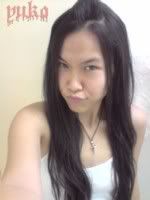Sunday, May 11, 2008
I used to kick my parents when I was sleeping or sleep in a different position without me realizing it till the following day when my parents actually asked “Did you have a bad dream?” I was puzzled what? So my mom said told me I kicked her
Let’s take a look below,
Which best describe the symptoms that I have …
I believe some people always claimed it was “ghostly” or being held by some invisible force that we are unclear about.
I used to think in that way as I was young didn’t know many things about sleeping disorder nor any one tells me about it. Naïve me always believe others saying … as years after years I realize it was just a purely sleeping disorder.
I am fascinated about horror movie, ghost stories and so on but I am not afraid nor do I find it is frightening at all. I strongly believe it is our minds that can play trick with us imagine you read day and night with ghostly story book each and every chapter and happening store in our brain without us knowing ….
It sounds contradicting at times when we said we believe and sometimes we said we don’t believe? In the things we had saw with our own eyes.
Sleeping disorder
Some common sleeping disorder
Bruxism Greek βρυγμός (brugmós), gnashing of teeth) is grinding of the teeth: The sufferer involuntarily grinds or clenches his or her teeth while sleeping.
Delayed sleep phase syndrome (DSPS): A sleep disorder of circadian rhythm, characterized by the inability to wake up and fall asleep at the desired times, but not by inability to stay asleep.
Bruxism can associate with other factors as followed,
High level of anxiety and or stress
Smoking
Digestive problem
Consumption of drugs and so on
Hypopnea syndrome: Abnormally shallow breathing or slow respiratory rate while sleeping.
Snoring
Choking sound
Not enough air to pass through the mouth and nose
The period silent lasted for 20 seconds or longer
Narcolepsy: The condition of falling asleep spontaneously and unwillingly at inappropriate times.
Night terror or Pavor nocturnus or sleep terror disorder: abrupt awakening from sleep with behavior consistent with terror.
Parasomnias: Include a variety of disruptive sleep-related events.
Periodic limb movement disorder (PLMD): Sudden involuntary movement of arms and/or legs during sleep, for example kicking the legs. Also known as nocturnal myoclonus. See also Hypnic jerk, which is not a disorder.
Rapid eye movement behavior disorder (RBD): Acting out violent or dramatic dreams while in REM sleep.
Restless legs syndrome (RLS): An irresistible urge to move legs. RLS sufferers often also have PLMD.
The sensations—and the need to move—may return immediately after ceasing movement, or at a later time. RLS may start at any age, including early childhood, and is a progressive disease for a certain portion of those afflicted, although the symptoms have disappeared permanently in some sufferers.
"An urge to move, usually due to uncomfortable sensations that occur primarily in the legs."
The sensations are unusual and unlike other common sensations, and those with RLS have a hard time describing them. People use words such as: uncomfortable, "antsy", electrical, creeping, painful, itching, pins and needles, pulling, creepy-crawly, ants inside the legs, and many others. The sensation and the urge can occur in any body part; the most cited location is legs, followed by arms. Some people have little or no sensation, yet still have a strong urge to move.
"Motor restlessness, expressed as activity that relieves the urge to move."
Movement will usually bring immediate relief, however, often only temporary and partial. Walking is most common; however, doing stretches, yoga, biking, or other physical activity may relieve the symptoms. Constant and fast up-and-down movement of the leg, coined "sewing machine legs" by at least one RLS sufferer, is often done to keep the sensations at bay without having to walk. Sometimes a specific type of movement will help a person more than another.
"Worsening of symptoms by relaxation."
Any type of inactivity involving sitting or lying—reading a book, a plane ride, watching TV or a movie, taking a nap—can trigger the sensations and urge to move. This depends on several factors: the severity of the person’s RLS, the degree of restfulness, the duration of the inactivity, etc.
"Variability over the course of the day-night cycle, with symptoms worse in the evening and early in the night."
While some only experience RLS at bedtime and others experience it throughout the day and night, most sufferers experience the worst symptoms in the evening and the least in the morning.
Shift work sleep disorder (SWSD).
Sleep apnea: The obstruction of the airway during sleep, causing loud snoring and sudden awakenings when breathing stops.
Sleep paralysis is characterized by temporary paralysis of the body shortly before or after sleep. Sleep paralysis may be accompanied by visual, auditory or tactile hallucinations.
Sleepwalking or somnambulism: Engaging in activities that are normally associated with wakefulness (such as eating or dressing), which may include walking, without the conscious knowledge of the subject.
I will blog more in the later days for further explanation ~Labels: sleeping disorder
Yuko writes @ 10:24 PM





 My Daily Life
My Daily Life 172
172 Mixedblood
Mixedblood Language's my love except mandarin
Language's my love except mandarin